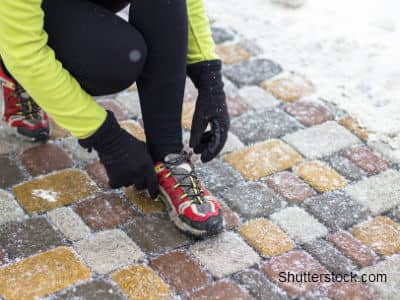
Consider the strenuous activities one is doing when they’re wearing athletic shoes. If you’re not wearing the proper supportive footwear, you could be a hop, skip or jump away from a sprained ankle or aching heel. Before you purchase your next pair of tennis shoes be sure that you’ve considered these important elements.
1. What kind of foot do you have?: First things first, it’s important to know whether you’ve got low arches, flat feet, and/or tend toward overpronation – which means your feet roll inward. If your feet suffer from overpronation then you’ll need to wear a shoe that creates extra wear on the outside heel and inside forefoot. Your shoe will need a shoe with a motion control feature that will provide maximum support. However, others may have a high arch which means they tend to underpronate and roll their feet outward. You’ll know if you have a high arch because your shoes will wear out mostly on the outside edge. Underpronation causes an excessive amount of wear on the outer edge of the heel and the little toe therefore, if this is your circumstance then you’ll want a cushioned shoe with a soft midsole. Then there are folks who have a neutral arch and their footprint has a distinct curve along the inside and wear shoes out uniformly. If you fall into this category, then you’ll want shoes that have the proper mix of cushioning and support.
2. Foot expansion: Over the course of the day your feet swell over and expand as you run and walk. When shopping for athletic shoes, it’s important to purchase shoes towards the end of the day because your feet will have expanded to their largest. You’ll want to make sure that your shoe is comfortable when it expands because your exercise routine will cause your feet to get bigger. Also, keep in mind that every brand’s shoe size is different. You may need a half size or possibly a full size smaller or larger than you originally thought. Always measure your foot if you’re unsure.
3. Understand the added items: When shopping you’ll find that every shoe is different. Some shoes have inserts, others are filled with gel, and some may even provide an extra shock absorption – be sure to educate yourself on what the added items actually do and determine whether or not you need them. Ask a professional before making the purchase and determine whether or not these added features suit your feet. For example, if you have heel pain opt for something that has extra shock absorption or if your ankles twist easily then choose a shoe that provides extra cushioning and less traction.
4. Know the categories: Get educated on the various categories of running shoes. There are road-running, train-running and cross-training shoes. Road-running shoes are designed for pavement and surfaces that are not always flat. These shoes are generally light and flexible and have a lot of cushion that stabilize shoes. Trail-running shoes are designed for runs that have rocks, mud, roots or other obstacles. These shoes have an enhanced tread for traction and offer underfoot protection. Cross-training shoes are for the gym or Crossfit workouts. These shoes have a thick sole and work well for balancing activities.
5. How do you run?: The way you run goes “foot-in-foot” with the shoe you select. Be sure that you check the wear pattern before purchasing a shoe so that you can distinguish whether your wear pattern is neutral pronation, overpronation or supination. Not only will your comfort be affected by how you run, but it will also help you determine where you need proper support.
6. Outsoles: Most running shoes are made with a rugged carbon rubber in the heel. Blown rubber provides more cushioning and in most cases is used in the forefoot. Most trail runners tend to have all carbon rubber outsoles so that they can withstand the trail. However, road racers prefer blown rubber to reduce the weight of the shoe. Consider what you’ll be using the athletic shoes for before you make a decision on the outsoles because it can improve your performance and comfort.
While all of this information may seem a little bit over top, keep in mind that these shoes are the only things providing you with comfort and protection when partaking in athletic activity. In addition, having the proper footwear will keep you safe and eliminate the possibility of injuries later down the road.

